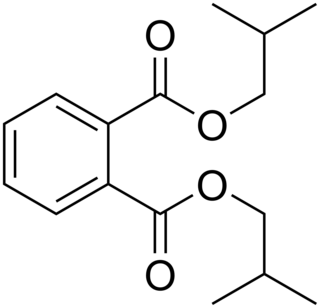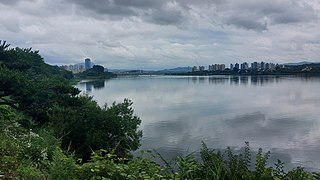
Phthalates, or phthalate esters, are esters of phthalic acid. They are mainly used as plasticizers, i.e., substances added to plastics to increase their flexibility, transparency, durability, and longevity. They are used primarily to soften polyvinyl chloride (PVC). Note that while phthalates are usually plasticizers, not all plasticizers are phthalates. The two terms are specific and unique and cannot be used interchangeably.

A plasticizer is a substance that is added to a material to make it softer and more flexible, to increase its plasticity, to decrease its viscosity, and/or to decrease friction during its handling in manufacture.
Substances, mixtures and exposure circumstances in this list have been classified by the International Agency for Research on Cancer (IARC) as group 3: The agent is not classifiable as to its carcinogenicity to humans. This category is used most commonly for agents, mixtures and exposure circumstances for which the evidence of carcinogenicity is inadequate in humans and inadequate or limited in experimental animals. Exceptionally, agents (mixtures) for which the evidence of carcinogenicity is inadequate in humans but sufficient in experimental animals may be placed in this category when there is strong evidence that the mechanism of carcinogenicity in experimental animals does not operate in humans. Agents, mixtures and exposure circumstances that do not fall into any other group are also placed in this category.

Butyraldehyde, also known as butanal, is an organic compound with the formula CH3(CH2)2CHO. This compound is the aldehyde derivative of butane. It is a colorless flammable liquid with an unpleasant smell. It is miscible with most organic solvents.

Bis(2-ethylhexyl) phthalate (di-2-ethylhexyl phthalate, diethylhexyl phthalate, diisooctyl phthalate, DEHP; incorrectly — dioctyl phthalate, DIOP) is an organic compound with the formula C6H4(CO2C8H17)2. DEHP is the most common member of the class of phthalates, which are used as plasticizers. It is the diester of phthalic acid and the branched-chain 2-ethylhexanol. This colorless viscous liquid is soluble in oil, but not in water.

Benzyl butyl phthalate (BBP) is an organic compound historically used a plasticizer, but which has now been largely phased out due to health concerns. It is a phthalate ester of containing benzyl alcohol, and n-butanol tail groups. Like most phthalates, BBP is non-volatile and remains liquid over a wide range of temperatures. It was mostly used as a plasticizer for PVC, but was also a common plasticizer for PVCA and PVB.

2-Ethylhexanol (abbreviated 2-EH) is an organic compound with formula C8H18O. It is a branched, eight-carbon chiral alcohol. It is a colorless liquid that is poorly soluble in water but soluble in most organic solvents. It is produced on a large scale (>2,000,000,000 kg/y) for use in numerous applications such as solvents, flavors, and fragrances and especially as a precursor for production of other chemicals such as emollients and plasticizers. It is encountered in plants, fruits, and wines. The odor has been reported as "heavy, earthy, and slightly floral" for the R enantiomer and "a light, sweet floral fragrance" for the S enantiomer.

Diisobutyl phthalate (DIBP) is a phthalate ester having the structural formula C6H4(COOCH2CH 2)2. It is formed by the esterification of isobutanol and phthalic anhydride. This and other phthalates are used as plasticizers due to their flexibility and durability. They are found in many industrial and personal products, such as lacquers, nail polish and cosmetics. DIBP can be absorbed via oral ingestion and dermal exposure. When it comes to excretion, DIBP is first converted into the hydrolytic monoester monoisobutyl phthalate (MIBP). The primary excretory route is urine, with biliary excretion being noted in minor amounts. DIBP has lower density and freezing point than the related compound dibutyl phthalate (DBP).
The enzyme carboxylesterase (or carboxylic-ester hydrolase, EC 3.1.1.1; systematic name carboxylic-ester hydrolase) catalyzes reactions of the following form:

Diethyl phthalate (DEP) is a phthalate ester. It occurs as a colourless liquid without significant odour but has a bitter, disagreeable taste. It is more dense than water and insoluble in water; hence, it sinks in water.
The molecular formula C24H38O4 (molar mass: 390.55 g/mol) may refer to:
Gapyeongcheon is a river of South Korea. It is a river of the Han River system. The Gapyeong Rail Park is located adjacent to the stream. The stream was found to be contaminated by bis(2-ethylhexyl) phthalate (DEHP) with 50 ppb.

Namhan River is a major river of South Korea, the 2nd-longest. It is a tributary of the Han River. It is famous for clean and clear water, especially in its upper reaches and tributaries, and serves as a source of water for Seoul. A popular bike path follows the river. Several sections of it are used for public recreation, including rafting; some of these sections have their own traditional names, such as the "Dong-gang" or Dong River stretch, popular for natural beauty.
Bis(2-ethylhexyl) terephthalate commonly abbreviated DEHT (Dioctyl terephthalate or DOTP), is an organic compound with the formula C6H4(CO2C8H17)2. It is a non-phthalate plasticizer, being the diester of terephthalic acid and the branched-chain 2-ethylhexanol, which is often generically referred to as octyl. This colorless viscous liquid is used for softening PVC plastics and is known for chemical similarity to general purpose phthalates such as DEHP and DINP, but without any negative regulatory pressure. It possesses very good plasticizing properties and may be used as a direct replacement for DEHP and DINP in many applications.
Streptomyces bangladeshensis is a thermophilic bacterium species from the genus of Streptomyces which has been isolated from soil in Natore in Bangladesh. Streptomyces bangladeshensis produces bis(2-ethylhexyl) phthalate.
Antiandrogens in the environment have become a topic of concern. Many industrial chemicals, including phthalates and pesticides, exhibit antiandrogen activity in animal experiments. Certain plant species have also been found to produce antiandrogens. In animal studies, environmental antiandrogens can harm reproductive organ development in fetuses exposed in utero as well as their offspring.
Professor Pravindra Kumar is an Indian biophysicist, bioinformatician, biochemist and Professor & Head Department of Biosciences and Bioengineering, Indian Institute Of Technology–Roorkee (IIT–Roorkee) India. He is known for his work on protein-protein interactions, protein engineering and structure-based drug design. Prof. Pravindra Kumar's primary research interest lies in studying Bacterial enzymes and pathways involved in the degradation of toxic aromatic compounds, such as PCBs, dibenzofuran, chlorodibenzofurans, DDT, dyes, and plastics/plasticizers. He focuses particularly on oxidoreductases enzymes due to their unique ability to catalyze challenging reactions, with a special emphasis on understanding their catalytic mechanisms and structural basis for guiding protein engineering. One notable achievement of his research group is the successful engineering of dioxygenases capable of metabolizing various toxic compounds, including those found in plastics.

Bis(2-methoxyethyl) phthalate, also commonly di(2-methoxyethyl) phthalate (DMEP), is a phthalate ester baring 2-methoxyethanol groups. Historically it was used as a plasticizer in cellulose acetate plastics, it is now largely banned owing to concerns over its effects to human health.

Bis(2-ethylhexyl)tetrabromophthalate (or TBPH), is a brominated phthalate derivative with the formula C24H34Br4O4 commonly used as a brominated flame retardant (BFR).












